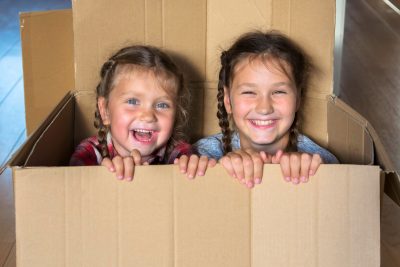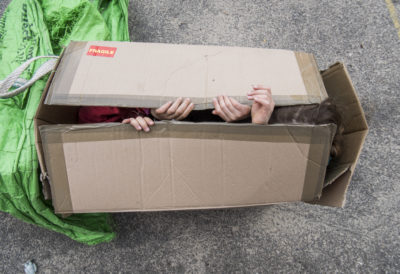
December: the month of the year when homes and businesses across the land are filled with excitement, laughter and…rubbish. Cardboard boxes, gift bags and a variety of other discarded packaging items. But before you head straight to the recycling bin, have you considered the value these items – loose parts in play speak – have for our children and young people?
What may look like rubbish to many can actually be great tools used to spark imagination, creativity and problem-solving skills. That box containing an enormous cuddly teddy offers endless possibilities to the curious mind of the child. One minute a car, the next an aeroplane or rocket ship. A quiet, cosy nook or a sneaky little hiding place. A puppet theatre, helmet, monster head, building block, boat, or a giant colouring sheet. The possibilities are endless, and you can be sure children will take time and find ways to explore them all in detail if allowed.
Having worked with younger children for many years, as well as having two of my own, I have first-hand experience of the power of the humble cardboard box. Often, it will seem the child has more interest in the packaging of a new toy than in the toy itself and this is certainly no surprise when you consider the endless play opportunities offered by a simple, open-ended resource compared to a toy with a defined way to play and a repetitive outcome. Just last week I witnessed my four and six year old children take a plain, unassuming box and transform it into a bus with nothing more than a cushion and some pushing and pulling. For two hours they were happily engrossed in their play. They took turns without being prompted and willingly transported each other between various bus stops – that afternoon our house became a castle, a zoo, school playground, play park and the moon (because anything is possible when children play!)
This play only came to an end when the box changed form and instead started to take shape as a bed for a cuddly toy. Out came the cushion, away went the pushing and pulling and in came a cosy blanket, a pan from the toy kitchen filled with shredded paper became a bowl and food for the toy dog and another blanket to cover over the box created a lovely little hideaway. When my eldest daughter decided the dog needed a window, off she went to find a pencil and scissors and together with her younger sister, created a small window, transforming the box from a bed to a kennel. What is clear here is that, not only were my children having fun and fully engaged in their play, but they were also developing so many skills along the way – all from one cardboard box!
But just what is it about cardboard boxes and other seemingly useless items that create so much interest in children? Put simply; any kind of open-ended resource affords a child endless opportunity to explore, create, experiment, and use their imagination and, as Albert Einstein once acknowledged, imagination is not to be undervalued:
“Imagination is more important than knowledge. For knowledge is limited to all we now know and understand, while imagination embraces the entire world, and all there ever will be to know and understand.”
Albert Einstein

In the 1970s, architect Simon Nicholson introduced the Theory of Loose Parts. This theory was founded on the belief that placing loose parts in an environment would empower creativity. The term ‘loose parts’ is used to describe any materials which can be used freely and have no defined purpose or instructions. Materials which can be manipulated by children; that is they can be moved, carried, built with, taken apart and redesigned in many different ways. Where given the chance to play in an open-ended way, children thrive.
Research shows that loose parts play stimulates a child’s natural curiosity and sparks their imagination as well as supporting the development of creativity, exploration, problem solving, critical thinking and social skills. And, perhaps the best thing about loose parts is that they don’t have to cost a penny! Yes, you can buy some wonderful, open-ended resources but often the best loose parts can be found in the home or garden. Boxes, wrapping paper, cardboard tubes from toilet or kitchen roll, dry pasta, bottle tops, egg boxes, baking trays or pans, yogurt pots, old greetings cards and magazines – all things you probably have around the house, gathering dust. Pinecones, leaves, feathers, sticks, pebbles – all things which can be readily found outdoors with the help of a child on a scavenger hunt.
For settings or homes with more space outdoor loose parts play offers further opportunity for exploration; tyres, pallets, crates, guttering, planks of wood, tarpaulins – a shout out to your local community or builders’ yard will certainly help gather larger resources.
A variety of resources, be they big or small, provide children with an environment full of possibilities and, as one of the great educational theorists of the last century tells us, children need these conditions to thrive.
“The wider the range of possibilities we offer children, the more intense will be their motivations and the richer their experiences.”
Loris Malguzzi
If you want to get started with loose parts, it couldn’t be simpler. Take a look around you for readily available resources. Leave something like a cardboard box out as a provocation for your child or children and just wait and see what happens; I can guarantee you will soon realise just how powerful the humble cardboard box can be!
If you would like to find out more about loose parts play, you can access the following resources:
If you would like to enquire about training or further resources for your home or setting, you can email our Learning and Development Officer:




